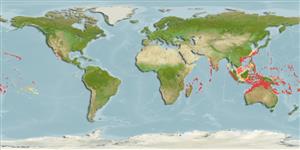Teleostei (teleosts) >
Tetraodontiformes (Puffers and filefishes) >
Balistidae (Triggerfishes)
Etymology: Xanthichthys: Greek, xanthos = yellow + Greek, ichthys = fish (Ref. 45335).
More on author: Bennett.
Environment: milieu / climate zone / depth range / distribution range
Ecology
Marine; reef-associated; depth range 8 - 150 m (Ref. 9770), usually 24 - 147 m (Ref. 1602). Tropical; 30°N - 23°S
Indo-Pacific: Mauritius eastward through northern Australia to the Hawaiian and Society islands, north to southern Japan.
Size / Weight / Age
Maturity: Lm ? range ? - ? cm
Max length : 30.0 cm TL male/unsexed; (Ref. 30874)
Occur in upper margins of current-swept seaward drop-offs and ledges (Ref. 205, 48637). Current-prone and with rich invertebrate growth such as seawhips. Usually found at moderate depths over 20 meters and occuring in small loose groups (Ref. 48637). Benthopelagic (Ref. 58302). Form loose aggregations a few meters above the bottom where it feeds on zooplankton, particularly copepods. Oviparous (Ref. 205). Also taken by drive-in nets (Ref. 9770).
Life cycle and mating behavior
Maturity | Reproduction | Spawning | Eggs | Fecundity | Larvae
Distinct pairing (Ref. 205).
Myers, R.F., 1991. Micronesian reef fishes. Second Ed. Coral Graphics, Barrigada, Guam. 298 p. (Ref. 1602)
IUCN Red List Status (Ref. 130435: Version 2024-1)
Threat to humans
Harmless
Human uses
Fisheries: subsistence fisheries; aquarium: commercial
Tools
Special reports
Download XML
Internet sources
Estimates based on models
Preferred temperature (Ref.
123201): 18.3 - 28.2, mean 25.1 °C (based on 350 cells).
Phylogenetic diversity index (Ref.
82804): PD
50 = 0.5078 [Uniqueness, from 0.5 = low to 2.0 = high].
Bayesian length-weight: a=0.02692 (0.01267 - 0.05719), b=2.92 (2.74 - 3.10), in cm total length, based on LWR estimates for this (Sub)family-body shape (Ref.
93245).
Trophic level (Ref.
69278): 3.0 ±0.00 se; based on food items.
Resilience (Ref.
120179): Medium, minimum population doubling time 1.4 - 4.4 years (Preliminary K or Fecundity.).
Fishing Vulnerability (Ref.
59153): Low vulnerability (20 of 100).
Nutrients (Ref.
124155): Calcium = 47.5 [20.3, 99.7] mg/100g; Iron = 0.716 [0.369, 1.665] mg/100g; Protein = 18 [16, 20] %; Omega3 = 0.121 [0.058, 0.251] g/100g; Selenium = 43.3 [20.4, 97.9] μg/100g; VitaminA = 78.5 [20.3, 304.5] μg/100g; Zinc = 1.07 [0.70, 1.61] mg/100g (wet weight);
